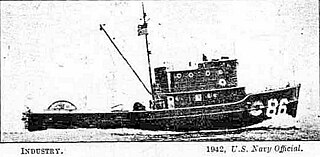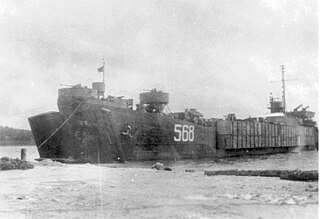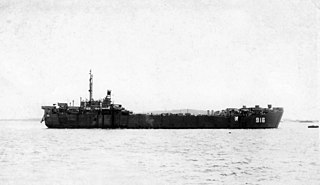
USS Munsee (AT/ATF-107) was an Abnaki-class fleet ocean tug. She is the only ship of the United States Navy to hold the name Munsee, which is the name of a subtribe of the Delaware Indians, still living in Wisconsin and Kansas.

USS Nestor (ARB-6) was planned as a United States Navy LST-491-class tank landing ship, but was redesignated as one of twelve Aristaeus-class battle damage repair ships built for the United States Navy during World War II. Named for Nestor, she was the only US Naval vessel to bear the name.

USS Sarpedon (ARB-7) was laid down as a United States Navy LST-542-class tank landing ship but was converted as one of twelve Aristaeus-class battle damage repair ships built for the Navy during World War II. Named for Sarpedon, and also she was the only US Naval vessel to bear the name.

USS Ulysses (ARB-9) was planned as a United States Navy LST-542-class tank landing ship, but was redesignated as one of twelve Aristaeus-class battle damage repair ships built for the United States Navy during World War II. Named for Ulysses, she was the second US Naval vessel to bear the name.
USS Romulus (ARL-22) was laid down as a United States Navy LST-542-class tank landing ship but converted to one of 39 Achelous-class repair ships that were used for repairing landing craft during World War II. Named for Romulus, she was the only US Naval vessel to bear the name.

USS Amphitrite (ARL-29) was one of 39 Achelous-class landing craft repair ships built for the United States Navy during World War II. Named for Amphitrite, she was the third U.S. Naval vessel to bear the name.
USS Mona Island (ARG-9) was laid down on 10 April 1944, as a Maritime Commission type (EC2-S-C1) hull, under Maritime Commission contract at Bethlehem Fairfield Shipyard, Inc., Baltimore, Maryland. Launched on 11 May 1944. Acquired by the U.S. Navy from the Maritime Commission and converted to Internal Combustion Engine Repair Ship (ARG-9) at Maryland Drydock Co, Baltimore, Maryland, and commissioned USS Mona Island (ARG-9), on 17 October 1944.

USS Pitkin County (LST-1082) was an LST-542-class tank landing ship built for the United States Navy during World War II. Named after Pitkin County, Colorado, she was the only U.S. Naval Vessel to bear the name.

USS Lipan (AT-85) was a Navajo-class fleet tug constructed for the United States Navy during World War II. Her purpose was to aid ships, usually by towing, on the high seas or in combat or post-combat areas, plus "other duties as assigned." She served in the Pacific Ocean during World War II and the Korean War. She was awarded two battle stars for World War II and four battle stars for the Korean War.
USS LST-888 was an LST-542-class tank landing ship built for the United States Navy during World War II. Late in her career she was renamed Lee County (LST-888) – after counties in twelve Southern and Midwestern states, the only U.S. Naval vessel to bear that name – but saw no active service under that name.
USS Valve (ARS-28) was a Diver-class rescue and salvage ship commissioned by the U.S. Navy during World War II. Her task was to come to the aid of stricken vessels.
USS Vent (ARS-29) was a Diver-class rescue and salvage ship commissioned by the U.S. Navy during World War II. Her task was to come to the aid of stricken vessels.

USS Industry (AMc-86) was an Accentor-class coastal minesweeper acquired by the U.S. Navy for the dangerous task of removing mines from minefields laid in the water to prevent ships from passing.

USS Wateree (ATF-117/AT-117) was an Abnaki-class fleet ocean tug acquired by the U.S. Navy during World War II. Wateree was sent to the western Pacific Ocean to perform towing services; however, during a typhoon, she was damaged beyond repair and lost, with eight crew members missing.

USS Baretta (AN-41/YN-60) was an Ailanthus-class net laying ship which served with the U.S. Navy in the western Pacific Ocean theatre of operations during World War II. After surviving war action and Pacific Ocean typhoons, and she returned home safely after the war with one battle star to her credit.
USS Mahogany (AN-23/YN-18) was an Aloe-class net laying ship which was assigned to serve the U.S. Navy during World War II with her protective anti-submarine nets.

USS LST-568 was a United States Navy LST-542-class tank landing ship in commission from 1944 to 1946.

USS LST-916 was an LST-542-class tank landing ship in the United States Navy. Like many of her class, she was not named and is properly referred to by her hull designation.

USS LST-779 was a United States Navy LST-542-class tank landing ship used in the Asiatic-Pacific Theater during World War II.

USS Jicarilla (ATF-104) was Abnaki-class tugboat during the World War II. The ship was later sold to Colombia as ARC Sebastián De Belalcázar (RM-73). Her namesake is a group of the Apache tribe found in the southwestern United States.













